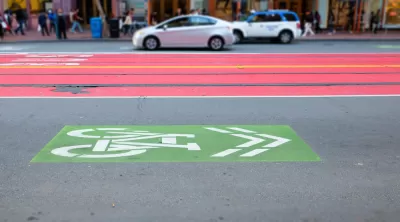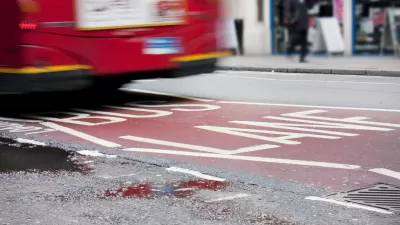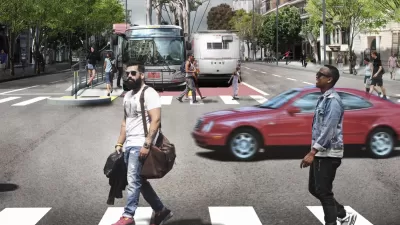The Federal Highway Administration approved 50 applications of red transit-only lanes to be painted throughout San Francisco. Already used on four streets in a pilot program, the lanes have proven effective but are opposed by some business owners.

The bus-only, red-colored transit lanes first appeared in 2013 as part of a demonstration project after gaining permission from state and federal authorities a year earlier. Very early on, they were shown to improve transit service, but they also provoked controversial among some business owners, homeowners and drivers who claimed they made auto travel more difficult and reduced access by motorists to stores adjacent to the transit lanes as some turns are prohibited.
On June 2, after reviewing the San Francisco Municipal Transportation Agency's Red Transit Lanes Final Evaluation Report of three such lanes, the Federal Highway Administration approved the agency's application for 50 additional streets, including "existing transit lanes and those proposed as part of projects like the Van Ness Improvement Project, the Geary Rapid Project and others in the Muni Forward Rapid Network," writes Aaron Bialick for SFMTA.
"Overall collisions on three red-colored streets — Geary, Third and O’Farrell streets — dropped by 16 percent and injury collisions dropped by 24 percent at a time when they did not change significantly citywide," reports Joe Fitzgerald Rodriguez, who covers transportation for the San Francisco Examiner.
“The data we’ve already seen shows this is a proven treatment that works. It works to improve reliability, and to reduce collisions, and that is a huge win,” said Rachel Hyden, executive director of the San Francisco Transit Riders advocacy group.
However, the lanes are still experiments, but "that soon may change," wrote Doug Hecox, a spokesperson for the administration, to the Examiner in an email.
If the lanes prove successful, red lanes will be approved by the National Committee on Uniform Traffic Control Devices, although they also are being used in the District of Columbia.
When installed, the SFMTA will report back to the highway administration on the number of vehicles driving in transit-only lanes, parking violations in the lanes, the behavior of private vehicles turning and blocking buses, collisions and transit travel time to measure their success.
For more findings on SFMTA's red lane evaluation report and a second analysis, see Bialick's April 7 blog, "Red Transit-Only Lanes Work: Two New Studies Show Their Benefits."

Red transit-only lanes on Market Street. Credit: SFMTA
FULL STORY: Federal approval will see Muni red lanes spread to 50 streets across SF

Planetizen Federal Action Tracker
A weekly monitor of how Trump’s orders and actions are impacting planners and planning in America.

Congressman Proposes Bill to Rename DC Metro “Trump Train”
The Make Autorail Great Again Act would withhold federal funding to the system until the Washington Metropolitan Area Transit Authority (WMATA), rebrands as the Washington Metropolitan Authority for Greater Access (WMAGA).

The Simple Legislative Tool Transforming Vacant Downtowns
In California, Michigan and Georgia, an easy win is bringing dollars — and delight — back to city centers.

Albuquerque’s Microtransit: A Planner’s Answer to Food Access Gaps
New microtransit vans in Albuquerque aim to close food access gaps by linking low-income areas to grocery stores, cutting travel times by 30 percent and offering planners a scalable model for equity-focused transit.

This City Will Pay You to Meet Your Neighbors
A North Kansas City grant program offers up to $400 for residents to throw neighborhood block parties.

Commentary: Our Silence Will Not Protect Us
Keeping our heads down and our language inoffensive is not the right response to the times we’re in. Solidarity and courage is.
Urban Design for Planners 1: Software Tools
This six-course series explores essential urban design concepts using open source software and equips planners with the tools they need to participate fully in the urban design process.
Planning for Universal Design
Learn the tools for implementing Universal Design in planning regulations.
Smith Gee Studio
City of Charlotte
City of Camden Redevelopment Agency
City of Astoria
Transportation Research & Education Center (TREC) at Portland State University
US High Speed Rail Association
City of Camden Redevelopment Agency
Municipality of Princeton (NJ)




























